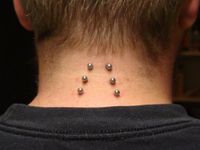Surface piercings
Surface piercings are any body piercings that take place on the surface of the body through areas which are not particularly concave or convex, where the piercing canal transverses a surface flap of skin, rather than running completely through a piece of body tissue from one side to another. A surface bar follows the plane of skin, while a standard piercing is pierced through the plane.
Sometimes surface piercings are difficult to heal, because, as the body rejects the body jewelry as a foreign object, the jewelry is pushed to the surface, causing the piercing to grow out. Proper placement and jewelry selection by an experienced body piercer can help alleviate this problem. A well-done surface can last anywhere between 3 months and several years.
Some more common, surface piercings are:
- Corset piercing, a series of bilaterally symmetrical piercings, normally done on the back, intended to be laced like a corset.
- Madison piercing, a horizontal piercing located just above the collarbone, at the base of the neck.
- Vertical Tragus, in front of the ear through the tragus.
- Nape piercing, located on the back of the neck.
- Neck piercing, located on the side of the neck. (Also called 'Vampire Bites')
- Hip piercing, located on the pelvis near the hips bones.
- Hand web piercing, located in the webbing between any of the fingers on the hand.
- Sternum piercing, located vertically or horizontally on the sternum.
- Wrist/Forearm piercing, located on or near the wrist, generally on the upper side.
- Stomach piercing, anywhere on the stomach but is usually close to the navel.
- Knuckles
- Finger
- Clavicles
Contrast these surface piercings with some common non-surface piercings:
- Ear piercing, located through either earlobe or any part of the cartilage of either ear.
- Nasal septum piercing, located through the thin membrane in the nasal cavity directly below the cartilage that makes up the nasal septum.
- Nostril piercing, located through the fold of skin comprising either nostril.
Rejection
Given the choice, your body doesn't want foreign objects inside itself, and that includes piercings. Rejection occurs when it is "easier" for your body to push the piercing out like a splinter than it is for your body to heal a fistula (skin tunnel) around it. Rejection is common among surface piercings as well as navel piercings and eyebrow piercings among others.
Rejection is affected by placement, blood flow, irritation, and abuse, as well as your general health. The healthier you are, the less likely you are to have problems.
External links
- BMEZine page on Surface Piercing Rejection - Explanation of various types of surface piercing techniques and rejection with several photos of piercings in the process of being rejected.
| Articles related to Piercings | |
|---|---|
| Piercing methods | Contemporary piercing procedures • Body piercing materials • Stretching • Play piercing • Pocketing • Surface piercing |
| Ear piercings | Tragus • Antitragus • Snug • Daith • Conch • Helix • Rook • Industrial |
| Facial and oral piercings | Cheek • Eyebrow • Anti-eyebrow • Lip (Labret) • Lip plate • Lip frenulum • Monroe • Medusa) • Nose (Bridge) • Tongue (Tongue frenulum) • Uvula |
| Body piercings | Corset • Hand web • Madison • Navel • Nipple • Nape |
| Female genital piercings | Christina • Clitoris • Clitoral hood • Triangle • Fourchette • Isabella • Labia • Nefertiti • Princess Albertina |
| Male genital piercings | Ampallang • Apadravya • Hafada • Foreskin • Deep shaft • Dolphin • Dydoe • Frenum • Frenum ladder • Guiche • Lorum • Magic Cross • Prince Albert • Reverse Prince Albert • Pubic • Transscrotal |
Chat rooms • What links here • Copyright info • Contact information • Category:Root
